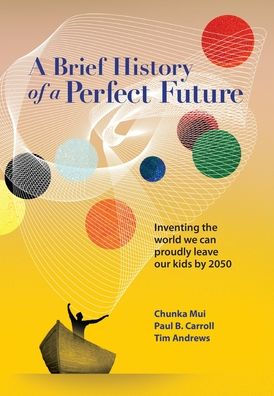
A Brief History of a Perfect Future: Inventing the World We Can Proudly Leave Our Kids by 2050
276
A Brief History of a Perfect Future: Inventing the World We Can Proudly Leave Our Kids by 2050
276Hardcover
-
PICK UP IN STORECheck Availability at Nearby Stores
Available within 2 business hours
Related collections and offers
Overview
The smartphone in your pocket could guide 120 million Apollo-era spacecraft to the moon and back, all at the same time. And whatever replaces that phone in 30 years will be a million times more powerful. Many other technologies are on similar trajectories, and the core tools of genomics - which let us understand and even manipulate genetic code - are actually improving far faster, with broad implications for our health, for the foods we eat, and for just about everything else.
How can a person even visualize a MILLION-fold improvement over 30 years, let alone a series of them that will interact with each other in profound ways? The traditional approach has been to think in bite-sized increments, of perhaps three to five years, and to let the rest of the future take care of itself. The authors propose a different way. They propose to harness the future, not to just let it happen.
They do the million-fold imagining for the reader, describing seven so-incredible-as-to-be-almost-magical technological building blocks that will be available to all of us in 2050. These building blocks-in computing, communication, information, genomics, energy, water, and transportation-are following what the authors have dubbed the Laws of Zero. The technologies are increasing in power so fast in cost that you can count on them heading toward zero(ish) cost over the next three decades, meaning that infinite(ish) amounts of those resources will be available.
The book paints visions of how the world could look if we all start planning now and experiment our way toward taking full advantage of the technological marvels that will be available. The authors provide what they call "future histories" - short, provocative "news" articles set in 2050 that describe how key aspects of the world might look in areas such as transportation, health care, climate, and trust.
It's easy to imagine falling into dystopian scenarios, a la those depicted in classics like 1984 and Brave New World. This book provides an optimistic vision of the future, very much grounded in facts and the lessons of history, while showing how individuals, companies, and governments can make this vision a reality.
The authors aren't claiming they can predict the future. They very much abide by the oft-used line that "it is difficult to make predictions, especially about the future." No, rather than predict the future, they want to draw on a lesson they learned from personal computing pioneer Alan Kay: "The best way to predict the future is to invent it." The authors want to invent a perfect future. More precisely, they want to help you invent it.

Product Details
| ISBN-13: | 9780989242042 |
|---|---|
| Publisher: | Future Histories Press |
| Publication date: | 09/21/2021 |
| Pages: | 276 |
| Product dimensions: | 6.00(w) x 9.00(h) x 0.75(d) |
About the Author
Paul B. Carroll was an award-winning journalist who spent 17 years as a reporter and editor at The Wall Street Journal. As a cofounder of and partner in the Future Histories Group, Paul now helps organizations shape their futures. He is the author or coauthor of five other books, including Big Blues: The Unmaking of IBM and Billion Dollar Lessons.
Tim Andrews is a technology leader in Booz Allen Hamilton's Civilian Services business. He's an expert in emerging technology and innovation, and large scale system design and development. Tim helps advance client missions through pragmatic use of leading edge technology.
Table of Contents
Introduction: Inventing the Future
PART ONE: THE LAWS OF ZERO
Chapter 1 The First Law of Zero: Computing
Chapter 2 The Second Law of Zero: Communication
Chapter 3 The Third Law of Zero: Information
Chapter 4 The Fourth Law of Zero: Genomics
Chapter 5 The Fifth Law of Zero: Energy
Chapter 6 The Sixth Law of Zero: Water
Chapter 7 The Seventh Law of Zero: Transportation
PART TWO: THE FUTURE HISTORIES
Chapter 8 Electricity
Chapter 9 Transportation
Chapter 10 Health Care
Chapter 11 Climate
Chapter 12 Trust
Chapter 13 Government Services
Coda What if the Future Isn't Perfect?
PART 3: JUMPSTARTING THE FUTURE
Chapter 14 What Individuals Can Do (Starting Now)
Chapter 15 What Companies Can Do (Starting Now)
Chapter 16 What Government Can Do (Starting Now)
Prologue: Over to You
Acknowledgments
Endnotes
Index
